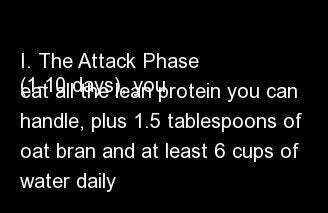The Dukan diet is no stranger to controversy, yet it continues to attract a steady stream of followers.
The protein-heavy diet has come under fire from such organisations as the British Dietetic Association.
Also, Dr Pierre Dukan - the man behind the strict plan - has made headlines himself for all the wrong reasons.
In 2013, he was given a ban from practising as a GP after it was reported he prescribed slimming pills that were linked to deaths in France. The ban was purely symbolic, as Dukan had retired as a GP.
Then in 2014, Dukan was struck off the French medical register for commercialising his slimming plan.
Taking all that into consideration, should you even consider trying the Dukan diet? Here's everything you need to know...

Dr Pierre Dukan
What Is The Dukan Diet?
The Dukan diet is made up of four phases - two designed to make you lose weight and two for stabilising the weight you get down to.
The diet uses a list of 100 permitted foods from which you can eat as much as you want - this is made up of 72 pure proteins (fish, meat, seafood, vegetable proteins and fat-free dairy products) and 28 vegetables. Details of these can be found on the official Dukan diet website.

Eggs are one of the animal proteins allowed in phase one.
Stage one of the diet is the "Attack" phase or the "Pure Protein (PP)" phase. The duration of the Dukan Attack phase depends on your age, weight and the number of diets you have done in the past, but it usually lasts from two to five days. Only natural pure protein foods are allowed during phase on - 68 animal proteins - in unlimited quantity.
Stage two is the "Cruise" phase, where dieters can gradually introduce vegetables into their diet on certain days, working towards the 100 permitted foods.
The third phase of the Dukan diet is the "Consolidation" phase - it lasts five days for every pound lost during previous phases. During this phase, dieters reintroduce "fun foods" outside of the unlimited 100 allowed foods.
Precise steps for this phase are detailed on the Dukan site. For example, a serving of fruit every day, excluding bananas, grapes, figs, and cherries, is permitted in the first half of the consolidation phase.
The fourth and final stage of the diet is the "Stabilisation" phase. The phase incorporates three steps in order to "help you gradually return to a varied, balanced diet": Eating three tablespoons of oat bran every day, having one pure protein day per week and taking the stairs, not the lift.
Story continues below slideshow:
Pros Of The Dukan Diet
Rapid initial weight loss can be seen as one advantage to the Dukan diet, British Dietetic Association spokesperson Rick Miller tells HuffPost UK Lifestyle.
"The books promises up to 10 pounds (4.5kg) of weight loss in the first week and this is due to the diet's very strict 'attack phase' which consists of unlimited lean protein and oat bran. For many individuals, seeing the weight come off quickly is motivating," he says.
He also points out that little choice in food while on the diet makes it easy to follow for some people aiming to lose weight.
"One of the hardest aspects of reducing weight for many individuals is integrating healthy eating advice into their own lifestyles," he says.
"The Dukan diet reduces this to a handful of foods for several weeks, whilst this not a normal dietary pattern, it’s very easy to follow."
SEE ALSO:
This Man Can Transform Your Body In 90 Days (And Here's The Proof)
Couple Lose 16 Stone By Swapping KFC For Weetabix-Coated Chicken
The fact that the Dukan diet does not include calorie counting or strictly monitoring portion sizes of food can also be appealing for some.
"Being aware of portion sizes and the energy density of foods (how many calories) is often part of the treatment process for individuals looking to lose weight and keep it off," Miller says.
"The Dukan diet does not encourage this, instead it restricts your choice to low energy density and satiating high protein, low fat, high fibre foods. It’s possible but much more difficult to overeat on vegetables, oat bran and lean meat."
Cons Of The Dukan Diet
According to the BDA, the Dukan diet is "nutritionally imbalanced" and dieters risk a number of side effects when taking on the plan.
"A diet that asks you to take a multi-vitamin and mineral from the outset is not designed to be used long term," Miller explains.
"Taking drastic measures and excluding large amounts of carbohydrate should not be necessary and could result in side effects such as dizziness, insomnia and nausea."
He also points out that the Dukan diet is unsustainable for anyone who wants to keep weight off long-term.
"Most individuals who seek to lose weight don’t want it to come back. Losing weight and body fat is as much about changing your relationship with food and integrating this into your lifestyle as it involves changing the foods on your plate," he says.
"Simply creating a huge restriction in your diet by excluding food groups teaches you nothing about flexibility and moderating your food intake, particularly for social occasions. This effectively ‘traps' individuals into a regime that may set them up for weight regain in the long run when they can’t ‘stay on the diet’."
We all know introducing exercise into our lifestyles is a great way to kickstart weight loss and keep our bodies health, but Miller says the Dukan diet forgets this vital component.
"The diet promotes a 20-minute walk per day but from the myriad of evidence we have on the benefits of exercise to multiple chronic conditions such as type 2 diabetes, heart disease and various cancers as well as weight loss, this is simply not enough," he says.
"Current UK department of health guidance is 150 minutes of moderate intensity activity a week (which is closer to 30 minutes a day), with no upper limit. There should also be a recommendation to integrate resistance exercise to help prevent muscle loss during the diet."
